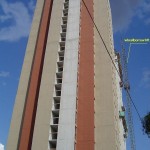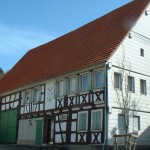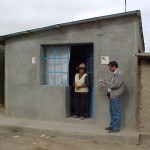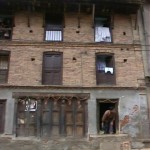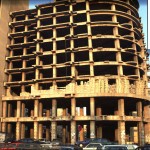by Heidi Faison, Craig D. Comartin, Kenneth Elwood
This report examines reinforced concrete buildings that use moment-resisting frames without ductile detailing to resist seismic loads. While this building type is predominantly used for office buildings and hotels, it is also used in urban areas for multi-family dwellings (condominiums) and university dormitories. It can be found in most urban areas across the country, though it is of particular concern in areas of high seismic hazard like California, Alaska, Washington, and Oregon. Building codes did not include requirements for special seismic detailing of reinforced concrete structures until the 1970’s when several earthquakes demonstrated the need for more ductile design. These buildings are vulnerable to numerous failure modes including: failure of column lap splices; strong beam/weak column failures; captive column failure; punching shear failures in flat plate slabs; and shear and axial load failure of columns with wide transverse reinforcement spacing. A discontinuity in stiffness and strength at the bottom story, due to a soft story, often results in a concentration of earthquake damage at the building base. Several examples of past earthquake behavior are given in this report as well as discussion of various retrofit options.
Archives for 2011
Report # 111 : Reinforced Concrete Moment Frame Building without Seismic Details
Report # 109 : Concrete Shear Wall Buildings
by Luis G. Mejia, Juan C. Ortiz R., Laura I. Osorio G.
These buildings are characterized mainly by cast-in-place, load-bearing, reinforced-concrete shear walls in both principal directions. The buildings are usually multiple housing units found in the major urban areas of Colombia, especially in the Andean and Caribbean regions. They represent about 2 to 3% of the housing stock in the cities with a population between one to seven million. These buildings typically have 7 to 20 stories, generally with a cast-in-place reinforced-concrete floor slab system. In general, these buildings have good seismic performance because of their regular mass distribution in height and symmetrical plan configuration and the great stiffness and strength of the walls that can restrict story drift to less than or equal to 0.005h. In some cases, if the buildings were constructed after the first Colombian Seismic Code in 1984, poor seismic detailing is found.
Report # 108 : Half-timbered house in the “border triangle” (Fachwerkhaus im Dreiländereck)
by Maria D. Bostenaru
This type of construction can be found in both the urban and rural areas of Germany, Switzerland, northern France, and England. The main load-bearing structure is timber frame. Brick masonry, adobe, or wooden planks are used as infill materials depending on the region. This report deals with the two latter types, because they are located in areas where strong earthquakes occur every century. However, this construction has proven particularly safe, and some of the buildings have existed for 700 years. These buildings have characteristic windows and a rectangular floor plan, with rooms opening to a central hall, which were later replaced by a courtyard. Typically, each housing unit is occupied by a single family. While in the past this was the housing of the poor, today affluent families live in these historic buildings. The load-bearing structure consists of a timbered joists and posts forming a single system with adobe or wooden infill. The walls consist of a colonnade of pillars supported by a threshold on the lower side and stiffened by crossbars and struts in the middle. On the upper part they are connected by a “Rahmholz.” The roof is steep with the gable overlooking the street. The floors consist of timber joists parallel to the gable plane with inserted ripples. The only notable seismic deficiency is the design for gravity loads only, while numerous earthquake-resilient features – the presence of diagonal braces, the achievement of equilibrium, the excellent connections between the bearing elements, the similar elasticity of the materials used (wood and eventually adobe) and the satisfactory three-dimensional conformation – have completely prevented patterns of earthquake damage. Since 1970, buildings in Switzerland are regulated by earthquake codes (latest update 1989). The 2002 edition will incorporate EC8 recommendations.
Report # 107 : Reinforced Adobe
by Daniel Quiun
This is a reinforcement system for existing adobe houses, as well as an adaptation for new adobe houses, with the objective to prevent their collapse under severe earthquakes. An extensive experimental research project was developed between 1994 and 1999, with the financial support of GTZ of Germany, the administration of CERESIS, and the execution of the Catholic University of Peru (PUCP). Several reinforcement techniques were studied, and it was concluded that the most appropriate was to reinforce the walls with horizontal and vertical strips of wire mesh electrically welded, covered with mortar. The technique was applied in 1998 as pilot projects in 20 houses in 6 cities in Peru. Later in 1999-2000 it was extended to Chile, Bolivia, Ecuador and Venezuela. We had to wait for an earthquake to assess the effectiveness of the reinforcement. In the earthquake of June 23, 2001 (Mw=8.4), that affected the south of Peru, six reinforced adobe houses had no damage. Neighboring dwellings of unreinforced adobe suffered heavy damage or collapsed. This success motivated several reconstruction programs of new reinforced adobe houses in the Andean zone, in which the technique was improved and applied in more than 500 houses, which are described herein. Shaking table tests on the system used in the new houses at the Structures Laboratory of PUCP demonstrated that the reinforcement provided is effective for resisting severe earthquakes without collapse. The August 15, 2007 Pisco earthquake (Mw8.0), 200 km south of Lima, also provoked the collapse of many traditional adobe houses. In Ica province, 5 houses were reinforced in 1998 using the wire mesh strips, and all withstand the earthquake undamaged.
Report # 103 : Single-family reinforced concrete frame houses
by Mohammed Farsi, Farah Lazzali
This privately owned housing constitutes about 60 to 70% of the housing stock and is widespread throughout northern Algeria, the region of the country’s highest seismic risk. Generally, these buildings are from 1 to 3 stories high. The ground floor is used for parking or for commercial purposes. The structural system consists of reinforced concrete frames with masonry infill walls made out of hollow brick tiles. The infill walls are usually provided in the residential part of the building (upper floors). Due to the limited amount of infill walls at the ground floor level, these buildings are characterized by soft-story behavior during earthquakes. These buildings have most often been built after the development of the 1981 Algerian seismic code. However, the seismic code is not enforced in private construction and most of the buildings have been built without seismic strengthening provisions and historically have been severely affected in Algerian earthquakes, including the May 21, 2003 Boumerdes earthquake. This report does not describe reinforced concrete frame buildings financed by public or private property developers and built according to the seismic code.
Report # 99 : Traditional Nawari house in Kathmandu Valley
by Dina D’Ayala, Samanta S. R. Bajracharya
The traditional newari house is usually of rectangular plan shape and developed over three storeys. The depth of the plan is usually about six metres with façades of various widths but most commonly between 4 to 8 metres (see also Korn 1976, and NSET-Nepal 2000). The organisation of the house is usually vertical, over 3 storeys, with a spine wall running through the height, creating front and back rooms. At the upper storey the spine wall is sometimes replaced by a timber frame system so as to create a larger continuous space. The staircase is usually a single flight to one side of the plan. The typical interstorey height is quite modest, between 2.20 and 2.50 m., including the floor structure. The bathroom, where present, is found at ground floor, while the kitchen is on the top floor, usually directly under the roof. The first floor is traditionally used as bedrooms, while the second floor is used as living room and for visitors’ reception. There are essentially two types of clusters of houses, either in long arrays, or around a court or chauk . In some cases the two types of clusters are adjacent with some units in common. In the arrays each house has front and back façade free. The construction of each unit is usually independent so that the facades are not continuum over party walls but each unit forms a separate cell. In such cases connection between façades and sidewalls are usually very good. The most interesting characteristic of these buildings both from an architectural and seismic point of view is the presence of the timber frame. Usually at ground floor, on the facade, to provide an open space for workshops or shops. It is also found internally at the upper storeys. In some cases the masonry only forms the outer shell while the internal structure is all made of timber elements. In the better built example of this typology there are a number of construction details, usually made of timber, which, coupled with the brick masonry walls, substantially improve the seismic performance of the overall structure. These features are best preserved in older examples. Currently these buildings are substantially being altered by use of western materials and technology, typically adding concrete frames as upper storeys. This type of intervention highly increases the vulnerability of the existing buildings.
Report # 97 : Medium/high rise moment resisting reinforced concrete frame building
by Maria D. Bostenaru
Such buildings generally range from 10 to 17 storeys in height with the ground floor being used for commercial purposes, whilst the upper floors house residential units. The vertical load bearing structure consists of moment-resisting reinforced-concrete frames which also generally serve as the lateral load-resisting system. However, when larger spans are encountered, reinforced-concrete structural walls are included to provide a dual structural system. Masonry infills built from lightweight concrete masonry units provide architectural space delineation. The seismic performance of such buildings constructed prior to 1977 varies from no damage to complete collapse. To date damage has usually been attributable to conceptual and construction mistakes.
Report # 96 : Early RC frame condominium building with masonry infill walls designed for gravity loads only
by Maria D. Bostenaru
This urban housing construction was practiced in Romania from 1907-1945, but predominantly in the 1930s, in the capital city of Bucharest. These buildings are mid- or high-rise (5-10 upper floors), often with two basements. Although there are several functional variations according to the usage and combination of flats, offices, and shops, this report discusses exclusive housing use. The number of housing units is variable. While smaller mid-rise buildings may contain one large luxury unit on each floor, taller buildings may include as many as eight small one-room flats, sometimes without a kitchen. The shape of the plan, containing L, U, H, or forms that cannot be described geometrically, and the elevation of the building are highly irregular. Upper floors may have recesses in the facade and may have corner towers. The load-bearing structure is RC skeleton designed for gravitational loads only. Columns are unevenly distributed so that beams at least one end are supported as secondary beams. Some beams are supported by columns with inadequate reinforcement or reduced sections of the RC members impede the formation of moment-resisting frames. The facade walls have solid clay brick masonry infill and improve the seismic behavior. The beneficial effect of masonry infill is influenced by the wall thickness, the size/position of openings in walls and the position of the partition wall to the frame. Staircases and elevators weaken the structure by introducing concentrated holes in flexible, thin RC slabs. Bucharest is located on alluvial soil deposits on river banks. Sandy ground or high levels of underground water have often presented problems for the foundation of buildings. Damaging earthquakes (M>7.0), centered in Vrancea, recur three times every century. These buildings were affected by the 1940 and 1977 earthquakes, but performed well relative to their high vulnerability. Out of the 61 buildings heavily damaged in the 1977 earthquake, 28 were of this type but were high-rise (7-9 floors).
Report # 95 : Prefabricated metal construction of the Modern Movement
by Maria D. Bostenaru
This urban housing construction was practiced for about 20 years during the early 1900s in Germany. Single-family houses and blocks of flats, both built according to the same construction system, are included in this report. This construction was built in what were once the outlying areas of German cities. Typically, these low-cost housing units are rented by the residents. The buildings consist of a row of several individual, 20-meter-long units, each of which usually contains two apartments on each floor. The load-bearing system is iron skeleton with brick infill. Usually, the skeleton is made out of columns and beams, but dense column grids were sometimes used to minimize the spans of metal joists as a cost-saving measure. Experiments with various materials for the bricks were tried as part of the continuous search for improved insulation. The floors are also made out of bricks on iron joists. Stiffening is usually provided by diagonal ties at the staircases, which are placed in the middle of each building unit. Because of the seismic activity, both along the Rhine and in the Swabian Jura affecting Baden-Wuerttemberg, seismic codes (DIN) were issued in 1981 and have been updated. Standards have existed since 1957 and are expected to be included in the new European code, Eurocode 8.
Report # 92 : Historic, braced frame timber buildings with masonry infill (‘Pombalino’ buildings)
by Rafaela Cardoso, Mario Lopes, Rita Bento, Dina D’Ayala
Pombalino buildings (see Figures 1, 2, 3 and 4) are historic masonry buildings that can be identified by the presence of a three-dimensional timber structure (named “gaiola pombalina”), which is enclosed in internal masonry walls above the first floor. The roofs are built with timber trusses clad with ceramic tiles and the floors are made of timber boards laid on timber joists. Ground floor walls are roughly dressed stone masonry supporting a system of vaults made of clay tiles, with stone arches. Foundations are made of short and small-diameter timber piles connected by a timber grid. These buildings were built after the 1755 earthquake when fear of new earthquakes led to the enforcement of anti-seismic provisions, such as establishing a maximum number of stories and introducing an interior timber structure called “gaiola.” The buildings originally were mixed-use with commercial enterprises on the ground floor and residences on the upper floors. During the 20th century, most Pombalino buildings underwent substantial refurbishment when they were converted and occupied entirely by banks and companies. For the buildings that have maintained their original uses, the main problems result from poor maintenance.The expected collapse mechanisms due to earthquake actions are the overturning of facades (out-of-plane) or shear failure at the plane of the walls at ground floor level (global shear mechanism), leading to a global collapse mechanism. Typical seismic strengthening of these buildings includes the introduction of a concrete/steel ring beam at the level of the roof eaves. The introduction of steel elements/pre-stressed cables or of anchors connecting parallel masonry walls is also common. Steel elements are also used to connect detached timber elements from the floors and gaiola to the masonry. New techniques applying new materials like Fibre Reinforced Polymers (FRP) are also used to increase the strength of the connections of timber elements that compose the gaiola.

